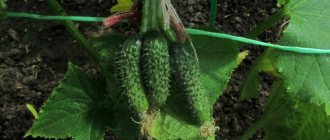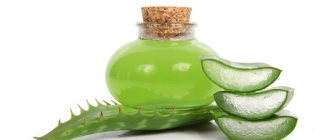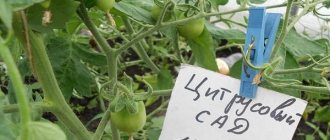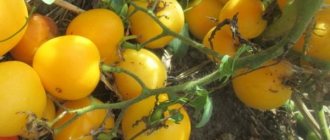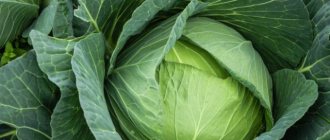Cabbage Transfer F1 is an early ripening hybrid of white cabbage, which occupies a significant share of the first vegetable market. The hybrid grows and bears fruit throughout Russia, tolerates weather vagaries, and rarely gets sick. The pulp has a wonderful taste and aroma.
| Landing location | Ripening time | View | Purpose | Origin | Maturation period | Weight |
| Open ground | Early ripening | White cabbage | Fresh, Cooking | Hybrid | 96-100 | 0,8–1,5 |
Description of the variety
The transfer was included in the state register of the Russian Federation in 1993. This hybrid is allowed for cultivation in all regions of the country, except for the northernmost corners of our country.
When describing Transfer cabbage, the first thing to note is its modest weight. The mass of heads of cabbage is only from 0.7 to 1.5 kg. They have a round shape. The cut forks are white. Density is average. There are voids around the periphery. The outside color is greenish-white. The inner stalk is short.
The rosette of the crop is semi-raised and compact. Cabbage leaves are round and slightly bubbly. They have a light green color. There is a waxy coating on their surface. There is slight waviness along the edge of the leaf.
The variety is recommended for fresh consumption. But it is also suitable for culinary processing.
Approximately 100 days pass from the first shoots to the moment of harvesting. Cabbage Transfer F1 ripens so quickly that it is considered ultra-early. This property gives an advantage when selling products on the market.
From 1 sq. m, you can harvest up to 7 kg of crop, which is more than the June cabbage variety. Product yield is 94%. And this is considered almost the highest indicator for an early ripening variety.
Plant care
Caring for planting cabbage consists of controlling humidity and proper hilling, as well as timely fertilizing.
Irrigation rates
Proper watering is the key to obtaining a high yield, since cabbage is a moisture-loving plant and requires a lot of water to form large heads of cabbage. At the same time, excessive waterlogging can lead to stunted vegetable growth.
Important! Flooding of the root system for 6–12 hours leads to the beginning of its death!
There are three watering methods:
- The simplest option is along the furrows, but this requires an even topography and does not provide uniform moisture. When watering in furrows, it is difficult to moisten the roots of young seedlings after planting. This method is not suitable for sandy loam and sandy soils.
- Sprinkling is suitable for areas with any terrain and any soil. This method allows you to regulate the desired rate, regulate humidity and refresh plants in the heat. The disadvantage of this method is the crust after watering, unevenness in strong winds and significant energy consumption.
- Drip irrigation is the most rational, allowing you to save water and supply it only to the plant. However, this method also has the highest cost and is also demanding on water quality.
Watering is best done in the morning or evening, with the desired water temperature being about +20°C. In hot weather, it is also recommended to carry out refreshing sprinkling (in the morning or evening). Watering is reduced during the period of cabbage ripening.
Read more about how often to water cabbage.
Fertilizer application
The amount of fertilizer needed for proper vegetable growth depends on the fertility of the soil and its preparation before planting. The most effective feeding is during the period of maximum leaf growth and during the formation of the head of cabbage.
The recommended feeding schedule is as follows:
- 2 weeks after planting the seedlings, feed with mullein solution (1:10, 500 ml per 1 seedling). This fertilizing can be skipped if fertilizers were added to the hole during planting;
- the second feeding is carried out a month after planting and is identical in composition to the first;
- the third feeding occurs 2 weeks after the second. Add 30 g of superphosphate per 10 liters of water to the same mullein solution and pour 1–1.5 liters per bush;
- The same solution can be used for the fourth feeding after 20 days.
Loosening and hilling
When the seedlings have taken root well, weeding and first loosening are carried out. The depth of loosening for the first time is 4-5 cm. After a week, the process is repeated to a depth of 6–8 cm. Subsequent loosening is carried out until the foliage of neighboring plants closes to a depth of 8–10 cm.
Hilling allows you to get additional roots and is carried out 25 days after planting the seedlings in open ground. It is performed after watering or fertilizing, raking the soil to the first true leaves. Since Larsia F1 has a short stalk, a second hilling is not required.
Did you know? Sauerkraut originated in China and was originally soaked in rice wine. It was this kind of lunch that was fed to those who built the Great Wall of China in the 3rd century BC. e.
Advantages
Transfer F1 cabbage has a number of positive qualities that distinguish it from other varieties, and allow farmers and vegetable growers to choose it.
- Excellent taste.
- High productivity.
- Resistance to major diseases.
- Withstands temperature changes, cold snaps in spring and even frosts down to minus 5°C.
- The variety does not require special conditions and effort when growing.
- The heads of cabbage are not prone to cracking, are relatively dense and juicy.
- The harvest is stable and friendly. The period between the ripening of the first and last heads can be only 6-8 days. Another convenience is that they are approximately the same size.
- Excellent presentation.
- Cabbage easily tolerates transportation.
Pests and diseases
The hybrid is resistant to major diseases. Its high immunity malfunctions if not properly cared for: the plant becomes vulnerable to clubroot, blackleg and powdery mildew.
- soil disinfection before sowing seeds and transplanting seedlings;
- seed disinfection;
- compliance with crop rotation (you cannot plant cabbage in beds where other cabbage, radishes, radishes or turnips were grown over the past 3-4 seasons);
- balanced feeding;
- pest and weed control;
- moderate watering;
- preventive spraying with biofungicide solutions.
If signs of clubroot appear (growths on the roots that prevent juices from flowing into the above-ground part of the bush), the plants are dug up and burned. The remaining ones are sprayed with a solution of colloidal sulfur, and lime is poured into the empty wells.
Black leg - rotting of the stems at the root. The disease occurs from excess dampness. They destroy diseased plants and reduce the intensity of watering, and for prevention, they treat healthy plantings with a fungicide.
Powdery mildew is a fungus that can be treated with fungicides containing copper (Hom, Bordeaux mixture or copper sulfate).
Dangerous pests include cruciferous flea beetles, aphids, slugs, cabbage flies, cutworm and white moth caterpillars, and bedbugs. For protection, sprinkle the plants with wood ash or shag or tobacco crushed into dust, regularly renewing the layer. Strong-smelling crops are planted around the perimeter: marigolds, onions, garlic, coriander.
If there are a lot of insects, the cabbage is treated with insecticides. But you cannot use chemicals after the heads have formed. In this case, prepare a solution of laundry soap, decoctions of wood ash, onion peels, garlic, celandine or tomato tops.
Flaws
A description of the shortcomings of Transfer cabbage also deserves due attention. After all, when choosing a variety, it is very important to understand all the pros and cons of the culture. This is the only way to achieve the desired result.
The plant may be attacked by the cruciferous flea beetle. To avoid this, you need to sprinkle the cabbage with dry ash.
In addition, Transfer cabbage needs weeding, hilling and loosening of the soil. You need to make sure that the seedlings do not stretch out, otherwise the plant will weaken. Early varieties of cabbage are more often attacked by pests. They suffer because of weeds.
Cabbage Transfer F1 cannot be salted or fermented. It also does not tolerate long-term storage. Can only be used for fresh consumption, as well as in first and second courses.
Basic rules for caring for plants
Nozomi is an unpretentious variety. This is one of the advantages due to which the hybrid has become popular. Caring for him is not difficult at all. The most effort will be required to water the plants.
Watering
Young seedlings with a small root system can get by with moderate watering. As it grows, its need for water also increases. Adult plants are watered frequently and abundantly. Watering frequency is approximately 3 times a week (every 2-3 days).
Under each bush you need to pour at least 2–3 liters of water so that the ground is wet to a depth of 50 cm.
Cabbage especially needs moisture when it is hot and when the heads are setting. During rainy times, watering is reduced or stopped. 2 weeks before cutting the heads of cabbage, water the cabbage less frequently or stop watering altogether. Water for irrigation should be settled. The best time for water treatments is evening or morning.
Important! With insufficient watering, loose heads of cabbage with unsucculent leaves are formed.
Feeding
The application of nutritional supplements is combined with watering. This contributes to the development of beautiful and tasty heads of cabbage. Early cabbage is fed 2-3 times per season:
- 2 weeks after transplanting, the seedlings are watered with an aqueous solution of mullein (1:7) or bird droppings (1:7), 1 liter per bush, if the leaves are pale, you need to add urea (15 g/10 l);
- when the heads are tied, the cabbage is strengthened with a slightly modified composition: a solution of mullein (1:5) or chicken droppings (1:10), adding wood ash (2 tablespoons per 10 liters of solution);
- after 20 days, water again with an organic solution without ash.
Loosening and weeding
After each water treatment, including rain, it is necessary to loosen the soil to a depth of 5 cm. This way, the dry crust is destroyed and air access to the roots is restored.
Simultaneously with loosening, weeding is also carried out. It is necessary to remove weeds along with their roots, as they often become a breeding ground for infections and insect larvae. If you mulch the soil with peat (5 cm), then there will be no need for weeding and loosening. Mulch retains moisture in the soil, prevents dry crust from forming and prevents the growth of weeds.
Experienced gardeners also advise hilling cabbage plants. Thanks to this, the seedlings form new roots, which serve as additional channels of nutrition.
Plant protection
Nozomi cabbage does not suffer from bacterial rot and Alternaria blight. But due to poor care, she can get sick with fungal diseases such as clubroot, blackleg and peronosporosis (downy mildew). For control and prevention, Bordeaux mixture (or other copper-containing products), lime solution, and biofungicides (Fitosporin, Trichodermin) are used.
Among the pests, cabbage plantings are threatened by the cabbage moth, the white butterfly and its caterpillars, the cutworm and the cruciferous flea beetle.
To rid plants of them, they are treated:
- folk remedies (ash-soap solution, tinctures of wormwood, dandelion root or tobacco, pollination with ashes or tobacco dust);
- chemical insecticides (“Kinmiks”);
- planted next to neighbors that repel neighbors (marigolds, carrots, dill, celery, calendula).
Agricultural technology
The best time for sowing seeds is the end of March-April. The planting depth is 1-1.5 cm. At 30-40 days it can be transplanted into open ground. The area for permanent residence of seedlings should be spacious, well lit and ventilated.
Transfer F1 cabbage ripens a whole week earlier than some early varieties. But to get an excellent harvest, you must follow some rules:
- soil preparation (fertilization and digging);
- regular watering with warm water;
- feeding;
- loosening, hilling;
- pest control;
- timely harvest.
How and when to plant
Before planting, it is necessary to prepare the site and seeds. Planting material should be placed in hot water for 15 minutes, then in cold water for 1 minute. After this, keep the grains in the refrigerator for a day. Before planting, dry the seeds so that they do not stick together.
The area for cabbage should be prepared in advance, in the fall. To do this, dig up the bed and then add organic matter. There are 10 kg per 1m2. You can use bird droppings and mullein. If the acidity level is elevated, then apply liming.
The Transfer variety is grown by seedlings. To do this, you need to prepare peat cups. This is due to the fact that early cabbage varieties do not tolerate transplantation well. Seeds must be sown in April. Within a week you can see the first shoots. Caring for seedlings comes down to regular watering and maintaining a temperature regime of 12-16 degrees. But you can learn from this description how to properly plant Podarok cabbage.
Video on how to plant cabbage:
Before planting plants in open ground, they must be hardened off. To do this, take the seedlings outside for 2-3 hours so that they can gradually get used to sunlight and wind. It will be possible to plant on the breast those plants that have already formed 5 leaves. This occurs 40-60 days after planting the seeds.
But what the Rinda cabbage variety looks like, and what features of its cultivation exist, is indicated in the article.
It is also worth reading the description about the Nadezhda cabbage variety and how it is grown in open ground.
What Megaton cabbage seedlings look like and how to plant them correctly in the ground is indicated here: //gidfermer.com/sadovodstvo/ovoshhevodstvo/kapusta-megaton-opisanie-sorta.html
But what Dutch varieties of cabbage exist, what they look like and are called, this information will help you understand.
Prepare holes in the garden bed. There should be a distance of 30 cm between them, and 50-60 cm between honey rows. Apply fertilizer to each hole. To do this, connect the following components:
- bird droppings – 10 kg;
- superphosphate – 40 g;
- wood ash – 500 g;
- urea - 5 g.
Reviews about cabbage Transfer
After reading reviews about Transfer F1 cabbage, you can draw your own conclusions whether you should plant this hybrid on your site or not.
Arthur Yakovlevich, Khabarovsk
Good cabbage, frost-resistant. This year the frosts returned when the seedlings were already growing in the garden; at night it was minus 7. Nothing... she survived. But the description on the bag is lying about cracking. I didn't water, it rained enough. The cabbage grew normally. But I didn’t collect everything at once. I don't need it. I’m used to cutting off the June one all summer long. But you can’t do that with Transfer. After 2 weeks everything burst, I had to quickly clean it up and feed all my relatives and friends.
Tatiana, Sarov
I really like Transfer. He keeps up faster than many. Moreover, you can already cut off a half-kilogram head. Juicy, sweet and no sores. It grows and grows. I watered it a little, loosened the soil and everything was fine. I do not practice hilling with this hybrid. This is not the late Moscow one. Its stalk is short and its roots go deep. The plant does not bend, the roots are not washed out. So I only fight the weeds and turn on a drop.
Oleg Ivanovich, Moscow Region, Klinsky district
I tried to grow Transfer, but it wasn’t my thing. Good cabbage, sweet, not harmful when grown. But it grows very small. If you plant the same June one, it will produce up to 2-3 kg of heads of cabbage. And this one is for one tooth. Just cut the salad for the family and that’s it. But the shoots are friendly and ripen almost in one day. So some people might like it.
Growing and care
Water after planting in small portions every 3–4 days. After a month, they switch to abundant watering once a week. Use water at room temperature and apply at the root.
After watering and rain, the soil is loosened every time.
Feed three times:
- 10–12 days after transplantation - organic fertilizer (manure, chicken droppings, diluted 1:10).
- 3 weeks after the first, repeat feeding or apply mineral nitrogen fertilizers.
- When forks appear, potassium and phosphorus are added.
Hybrid characteristics (table)
| Variety or hybrid | hybrid |
| Ripening time | ultra-early |
| Kochan | round, medium density, there are voids along the periphery |
| Kocheryzhka | short |
| Disease resistance | high resistance to diseases |
| Fruit weight, g | 700-1200 |
| Growing areas | central and southern regions of the Russian Federation, Ukraine, Kazakhstan, Moldova |
| Disembarkation scheme | 50cm x 40cm |
| From germination to ripeness | 92-100 days |
| Seed placement depth | 1.0-1.5 cm |
| Seedling age | 30-40 days |
| Soil temperature for planting seeds/seedlings | +4/+12 |
| Advantages | resistant to diseases, good marketability and taste, good transportability |
| Flaws | affected by the cruciferous flea beetle, cannot be fermented or stored |
Landing
The dates for sowing seeds for seedlings are the last ten days of March and the first ten days of April. How and when to plant? In the south you can plant earlier, in Siberia and the Urals - later. Before sowing, seeds sold without colored shells are treated:
- soak for 20 minutes in a solution of potassium permanganate at a temperature of +50 degrees;
- rinse for 2–3 minutes in cold, clean water;
- if desired, soak in a solution of a growth stimulator (Epin or Zircon).
The soil is prepared from humus, peat, turf soil, sand and compost. The ingredients, except peat, are taken in equal quantities, then 10% peat and a little wood ash are added. Pour the mixture with a hot solution of potassium permanganate or leave it in the oven for half an hour at +100 degrees.
To avoid unnecessary injury to the roots during transplantation, it is better to use individual containers: peat pots or tablets or plastic glasses.
Furrows 0.5 cm deep are made in the soil, the seeds are laid out, leaving 3–5 cm grooves. Water and germinate at room temperature under a transparent film. With the emergence of seedlings, remove the film, reduce the temperature to +14–17 degrees and provide long-term lighting. If there is not enough sun, lamps are used.
Plants emerge from common boxes after 10–12 days. When planting in individual pots, thin out. A week or two before transplanting, the seedlings are hardened off. Planted according to a 40 by 50 cm pattern.
Positive and negative qualities of a hybrid
The hybrid has a long list of advantages that distinguish it from other early varieties of cabbage. The domestic vegetable is famous primarily for the following positive qualities:
- Good taste. Taste qualities of Transfer F1 – 4.0-4.8 points out of 5.
- Good immunity. Protection against most cabbage diseases.
- The plant is not afraid of low temperatures.
- Transfer F1 is one of the most unpretentious hybrids to grow.
- Heads of cabbage are not prone to cracking and are easily transported over long distances.
- The harvest ripens together.
- Transfer F1 has an attractive presentation, thanks to which cabbage is well sold on the market.
However, it is worth noting the disadvantages of this hybrid. These include:
- The plant is practically not protected from insect attack (in general, like any other early cabbage). In particular, Transfer is often infested by the cruciferous flea beetle. To protect yourself from this parasite, you need to sprinkle the vegetable with wood ash.
- The hybrid is not suitable for pickling or pickling.
- It has a short shelf life both on the root and in the cellar.
The hybrid responds very well to watering. After dipping the seedlings into the exhaust gas, they are watered every 2-3 days. Approximately 7-8 liters of water are consumed per 1m2. Watering is gradually transferred to the “once a week” mode. And so on until the forks are laid. Then watering is carried out more often again, as the plant enters the active phase of the growing season.
Seedless growing method
Seeds must be prepared for planting
Seeds using the seedless planting method are carefully prepared.
Description of necessary activities:
- soak the selected seeds for 10-15 minutes in ice water;
- place them in a nutrient solution with microelements for 12 hours;
- rinse with clean running water;
- wipe dry;
- place in the refrigerator for 24 hours.
The soil must be fertile, with high moisture capacity, and well cultivated. Sowing begins at a soil temperature of 8-10°C. Seeds are sown to a depth of 2-3 cm.
After the emergence of seedlings, the soil between the rows is loosened. After 3-4 leaves appear, thinning is carried out. Keep a distance of 35-50 cm between plants.
Further care for cabbage consists of regular watering, applying various fertilizers, and controlling weeds and pests.
It is not difficult to follow the rules, but failure to comply with at least one of these rules and violation of the deadlines for their implementation leads to a significant reduction or complete loss of the crop.
Watering
Hybrid Transfer f1 is a moisture-loving vegetable crop. Optimal soil moisture conditions are not lower than 75% in the area where the cabbage root system is located. Watering is carried out depending on weather conditions.
The fruit may crack due to overwatering or sudden fluctuations in soil moisture.
Weed control
Plant protection from weeds includes a complex of agrotechnical and chemical measures carried out at different periods of crop growth.
- crop rotation;
- pre-sowing treatment;
- inter-row processing;
- manual weeding.
Chemical methods of protection:
- application of continuous action herbicides;
- use of selective herbicides.
Continuous action herbicides are used before planting seedlings in the soil or, in the non-seedling method, before seed germination. These drugs include Roundup, Tornado, Glyphos, etc.
Selective herbicides are applied after germination. These include the following drugs: Treflan, Lontrel, Panther, Targasuper, Fusilad Forte, etc.
Pest Control
To obtain a high-quality harvest, pests are periodically controlled.
- timely destruction of weeds and post-harvest residues,
- loosening row spacing during the caterpillar pupation period,
- culling damaged seedlings,
- treating seeds with insecticides.
In pest control, contact-systemic insecticides (Konfidor, Zolon, Aktara, Bi-58) are used by spraying. They are used in case of mass spread of pests strictly in accordance with the manufacturer’s instructions.
Fertilizer application
Fertilizing is carried out 10-14 days after planting the seedlings. With the seedless planting method, fertilizers are applied fractionally, depending on the condition of the plant.
Mullein at a dosage of 1:10 or chicken manure at a dosage of 1:12 are suitable for these purposes. After 10 days, fertilizing is repeated. After watering, the procedure is more effective. You can sprinkle the soil with wood ash: it perfectly nourishes and protects from pests.


